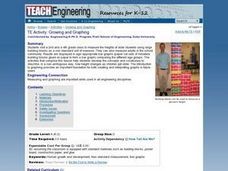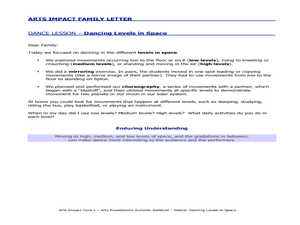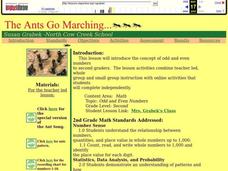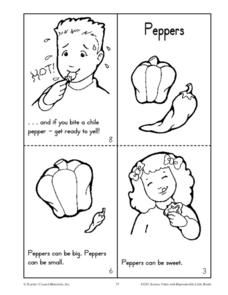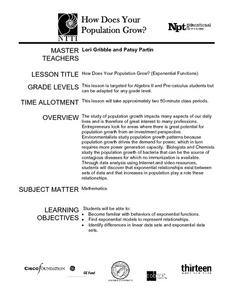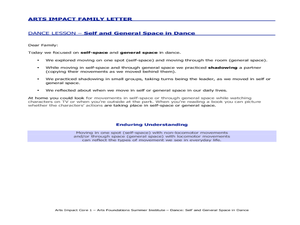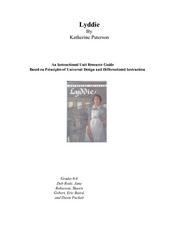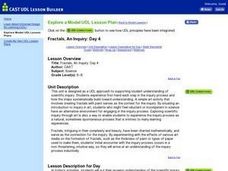Curated OER
How Does Your Garden Grow?
Students construct and maintain a school garden. In this gardening lesson, students plan the construction of the garden by writing letters to local businesses asking for supplies and materials; students build the garden using their math...
Curated OER
Growing and Graphing
Pupils visit a 2nd and a 4th grade class to measure the heights of older students using large building blocks as a non-standard unit of measure. They can also measure adults in the school community. Results are displayed in...
Curated OER
Dancing Levels in Space
Students practice mirroring human moves by performing a dance in class. In this physical education lesson, students utilize different spaces around them to perform a dance expressing their full motion. Students cooperate in...
Curated OER
Investigation - Looking For Triangles
Seventh graders investigate a series of triangles, looking for patterns and generalizing what they have found. They analyze the pattern data and organize it into a table and graph. Students identify the relationship and discover the rule...
Curated OER
Germs and Your Body
Students study germs and ways your body fights against disease. For this germs lesson students complete an activity that demonstrates where germs can get into your body.
Curated OER
Odd and Even
Explore the concept of odd and even with your class using this resource. Learners take an online test demonstrating their knowledge of odd and even, sing a song about the concept, and engage in computer-based activities.
Curated OER
Chile Peppers
For this Language Arts worksheet, learners read about peppers and participate in a variety of related activities. For example, students create a chile pepper pattern.
Curated OER
Planting Wheat with Little Red Hen
Young scholars discuss the cycle of growing wheat, and then plant their own in foil pans. After the wheat grows for a couple of weeks, students participate in a story retelling activity reinforcing the concepts of the process.
Curated OER
Graphing the Population Explosion of Weeds
Students are introduced to the seed cycle and draw the specific steps. In groups, they identify the human barriers to the spreading of weeds. After calculating the rate of spreading of the Yellowstar Thistle, they create graphs to see a...
Curated OER
How Does Your Population Grown?
Do you know how the population has grown of your community? Can you predict the population over the next half century? Can we find an algebraic model that matches our data? These along with many more questions can be researched by...
Curated OER
What's For Dinner?
Eighth graders discover how the location of restaurants affects the future location of different restaurants. Using a fictionous town, they map the locations of all current restaurants and analyze the data to determine what type of...
Curated OER
Where Does Our Food Come From?
Fourth graders identify the state or country that a food product came from and locate it on a map. They identify products that are grown in Hawaii and the factors important in the location of economic activities.
Curated OER
Starfish Challenge
In this starfish activity activity, students respond to 10 multiple choice questions that require them to exhibit the knowledge they have regarding starfish.
Curated OER
All A-buzz About Math
Second graders participate in Math-Eze activities to comprehend word problems. In this word problem lesson, 2nd graders recognize why a hexagon is the best shape for a beehive. Students calculate how far bees must travel to find 2 lbs....
Curated OER
Growing Rock Candy
Students observe the growth of rock candy. In this crystal growth instructional activity, students make rock candy and measure the crystal growth over five days.
Curated OER
What Do I Want To Be When I Grow Up?
Students explore numerous types of careers. As a class, they list people they know and the types of jobs and services that are provided. Students discuss the responsibilities of having a job. Volunteer students explain what they wish...
Curated OER
Growing Circles
Students identify the equation to represent a circle. In this algebra lesson, students review properties of conics and how they are related. they use a robot to create a visual of circles and their application to the real world.
Mathematics Vision Project
Quadratic Functions
Inquiry-based learning and investigations form the basis of a deep understanding of quadratic functions in a very thorough unit plan. Learners develop recursive and closed methods for representing real-life situations,...
Curated OER
Self and General Space in Dance
Students explore the different themes and strategies of dancing by performing in class. In this physical education instructional activity, students practice moving specific joints and muscles as they train to perform a dance....
Curated OER
Cause and Effect: Light Clusters and Geography
After viewing a map of lights at night over a variety of geographic formations, young topographers connect the location of light clusters to geographic features that encourage human settlement. They list causes and effects of large...
Curated OER
Lyddie: An Instructional Unit Resource Guide
Katherine Paterson’s young adult novel Lyddie is the foundation of a differentiated instruction unit that not only explores the rise of industrialization and labor but women’s rights issues as well. After learners read the novel, they...
Curated OER
Himalayan Herds: Fractional Exponential Growth
Young scholars solve problems by identifying exponential growth and decay and differentiating between patterns, relation and functions. For this algebra lesson, students apply concepts of exponential growth to solve problems.
Curated OER
Fractals, An Inquiry: Day 4
Students put their growing understanding of the scientific inquiry process to work. They use paint to implement their plans to experiment with how changing one aspect of the fractal making process influences their appearance.
Curated OER
A Changing Society: Industrialization and Urbanization
Students participate in activities that teach them about the Gilded Age of industrialization and urbanization. In this social changing lesson plan, students answer questions, watch videos, have discussions, read texts, and more to teach...

